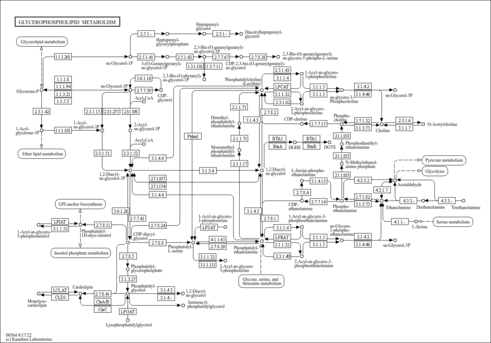| Record Information |
|---|
| Version | 1.0 |
|---|
| Created at | 2020-03-30 17:47:08 UTC |
|---|
| Updated at | 2020-12-07 19:07:48 UTC |
|---|
| CannabisDB ID | CDB000852 |
|---|
| Secondary Accession Numbers | Not Available |
|---|
| Cannabis Compound Identification |
|---|
| Common Name | CDP-DG(16:0/16:0) |
|---|
| Description | CDP-DG(16:0/16:0) belongs to the family of CDP-diacylglycerols. It is a glycerophospholipid containing a diacylglycerol, with a cytidine diphosphate attached to the oxygen O1 or O2 of the glycerol part. As is the case with diacylglycerols, phosphatidylserines can have many different combinations of fatty acids of varying lengths and saturation attached to the C-1 and C-2 positions. CDP-DG(16:0/16:0), in particular, consists of two hexadecanoyl chain at positions C-1 and C2. In E. coli glycerophospholipid metabolism, The biosynthesis of CDP-diacylglycerol (CDP-DG) involves condensation of phosphatidic acid (PA) and cytidine triphosphate, with elimination of pyrophosphate, catalysed by the enzyme CDP-diacylglycerol synthase. The resulting CDP-diacylglycerol can be utilized immediately for the synthesis of phosphatidylglycerol (PG), and thence cardiolipin (CL), and of phosphatidylinositol (PI). CDP-DG(16:0/16:0) is also a substrate of CDP-diacylglycerol pyrophosphatase. It is involved in CDP-diacylglycerol degradation pathway. This compound is expected to be in Cannabis as all living plants are known to produce and metabolize it. |
|---|
| Structure | |
|---|
| Synonyms | | Value | Source |
|---|
| 1,2-Dihexadecanoyl-rac-glycero-3-CDP | HMDB | | 1,2-Dipalmitoyl-rac-glycero-3-cytidine-5'-diphosphate | HMDB | | CDP-DG(32:0) | HMDB | | CDP-Diacylglycerol(16:0/16:0) | HMDB | | CDP-Diacylglycerol(32:0) | HMDB |
|
|---|
| Chemical Formula | C44H81N3O15P2 |
|---|
| Average Molecular Weight | 954.09 |
|---|
| Monoisotopic Molecular Weight | 953.5143 |
|---|
| IUPAC Name | {[(2R,3R,5R)-5-(4-amino-2-oxo-1,2-dihydropyrimidin-1-yl)-3,4-dihydroxyoxolan-2-yl]methoxy}({[(2R)-2,3-bis(hexadecanoyloxy)propoxy](hydroxy)phosphoryl}oxy)phosphinic acid |
|---|
| Traditional Name | [(2R,3R,5R)-5-(4-amino-2-oxopyrimidin-1-yl)-3,4-dihydroxyoxolan-2-yl]methoxy([(2R)-2,3-bis(hexadecanoyloxy)propoxy(hydroxy)phosphoryl]oxy)phosphinic acid |
|---|
| CAS Registry Number | Not Available |
|---|
| SMILES | [H][C@@](COC(=O)CCCCCCCCCCCCCCC)(COP(O)(=O)OP(O)(=O)OC[C@H]1O[C@H](C(O)[C@H]1O)N1C=CC(N)=NC1=O)OC(=O)CCCCCCCCCCCCCCC |
|---|
| InChI Identifier | InChI=1S/C44H81N3O15P2/c1-3-5-7-9-11-13-15-17-19-21-23-25-27-29-39(48)57-33-36(60-40(49)30-28-26-24-22-20-18-16-14-12-10-8-6-4-2)34-58-63(53,54)62-64(55,56)59-35-37-41(50)42(51)43(61-37)47-32-31-38(45)46-44(47)52/h31-32,36-37,41-43,50-51H,3-30,33-35H2,1-2H3,(H,53,54)(H,55,56)(H2,45,46,52)/t36-,37-,41+,42?,43-/m1/s1 |
|---|
| InChI Key | ITYHVANGBZMQML-QDFYKRCGSA-N |
|---|
| Chemical Taxonomy |
|---|
| Description | Belongs to the class of organic compounds known as cdp-diacylglycerols. These are glycerolipids containing a diacylglycerol, with a cytidine diphosphate attached to the oxygen O1 or O2 of the glycerol part. |
|---|
| Kingdom | Organic compounds |
|---|
| Super Class | Lipids and lipid-like molecules |
|---|
| Class | Glycerophospholipids |
|---|
| Sub Class | CDP-glycerols |
|---|
| Direct Parent | CDP-diacylglycerols |
|---|
| Alternative Parents | |
|---|
| Substituents | - Cdp-diacylglycerol
- Pyrimidine ribonucleoside diphosphate
- Diacyl-glycerol-3-pyrophosphate
- Pentose phosphate
- Pentose-5-phosphate
- Glycosyl compound
- N-glycosyl compound
- Monosaccharide phosphate
- Organic pyrophosphate
- Pentose monosaccharide
- Aminopyrimidine
- Fatty acid ester
- Pyrimidone
- Monoalkyl phosphate
- Imidolactam
- Pyrimidine
- Fatty acyl
- Alkyl phosphate
- Phosphoric acid ester
- Dicarboxylic acid or derivatives
- Hydropyrimidine
- Organic phosphoric acid derivative
- Monosaccharide
- Tetrahydrofuran
- Heteroaromatic compound
- Secondary alcohol
- Amino acid or derivatives
- 1,2-diol
- Carboxylic acid ester
- Organoheterocyclic compound
- Azacycle
- Oxacycle
- Carboxylic acid derivative
- Alcohol
- Organonitrogen compound
- Organic nitrogen compound
- Organooxygen compound
- Amine
- Carbonyl group
- Primary amine
- Organic oxygen compound
- Organopnictogen compound
- Hydrocarbon derivative
- Organic oxide
- Aromatic heteromonocyclic compound
|
|---|
| Molecular Framework | Aromatic heteromonocyclic compounds |
|---|
| External Descriptors | |
|---|
| Ontology |
|---|
|
| Physiological effect | Organoleptic effect: |
|---|
| Disposition | Route of exposure: Source: Biological location: |
|---|
| Role | Industrial application: Biological role: |
|---|
| Physical Properties |
|---|
| State | Solid |
|---|
| Experimental Properties | | Property | Value | Reference |
|---|
| Melting Point | Not Available | Not Available | | Boiling Point | Not Available | Not Available | | Water Solubility | Not Available | Not Available | | logP | Not Available | Not Available |
|
|---|
| Predicted Properties | [] |
|---|
| MS/MS | | Type | Description | Splash Key | View |
|---|
| Predicted MS/MS | Predicted LC-MS/MS Spectrum - 10V, Positive | splash10-03di-0910001001-c3de6e15431b5ac5105e | 2017-09-01 | View Spectrum | | Predicted MS/MS | Predicted LC-MS/MS Spectrum - 20V, Positive | splash10-03di-1910001000-94fe74d873da591ba587 | 2017-09-01 | View Spectrum | | Predicted MS/MS | Predicted LC-MS/MS Spectrum - 40V, Positive | splash10-03di-3920010100-8cfc73d1ce30a6c32997 | 2017-09-01 | View Spectrum | | Predicted MS/MS | Predicted LC-MS/MS Spectrum - 10V, Negative | splash10-0a4i-0980001205-1542b6ae52ff3efc590a | 2017-09-01 | View Spectrum | | Predicted MS/MS | Predicted LC-MS/MS Spectrum - 20V, Negative | splash10-0bt9-5792301301-02cf7e042d4983495f65 | 2017-09-01 | View Spectrum | | Predicted MS/MS | Predicted LC-MS/MS Spectrum - 40V, Negative | splash10-0bt9-5910000000-476fcc03a8d550c335c6 | 2017-09-01 | View Spectrum | | Predicted MS/MS | Predicted LC-MS/MS Spectrum - 10V, Positive | splash10-0udi-2100010059-d69dd9d87d36fe9fe53c | 2021-09-24 | View Spectrum | | Predicted MS/MS | Predicted LC-MS/MS Spectrum - 20V, Positive | splash10-0btc-5000000192-0d1381c2685c4916fe9d | 2021-09-24 | View Spectrum | | Predicted MS/MS | Predicted LC-MS/MS Spectrum - 40V, Positive | splash10-006w-0039300000-1610b6659c074d77d1cd | 2021-09-24 | View Spectrum | | Predicted MS/MS | Predicted LC-MS/MS Spectrum - 10V, Negative | splash10-0udi-0000001009-3a3e7d7fc874243c5cc1 | 2021-09-24 | View Spectrum | | Predicted MS/MS | Predicted LC-MS/MS Spectrum - 20V, Negative | splash10-0573-9050611301-a5605075e8ba8a1894b8 | 2021-09-24 | View Spectrum | | Predicted MS/MS | Predicted LC-MS/MS Spectrum - 40V, Negative | splash10-053r-6439605102-0e715a1320fb44e4b4a2 | 2021-09-24 | View Spectrum |
|
|---|
